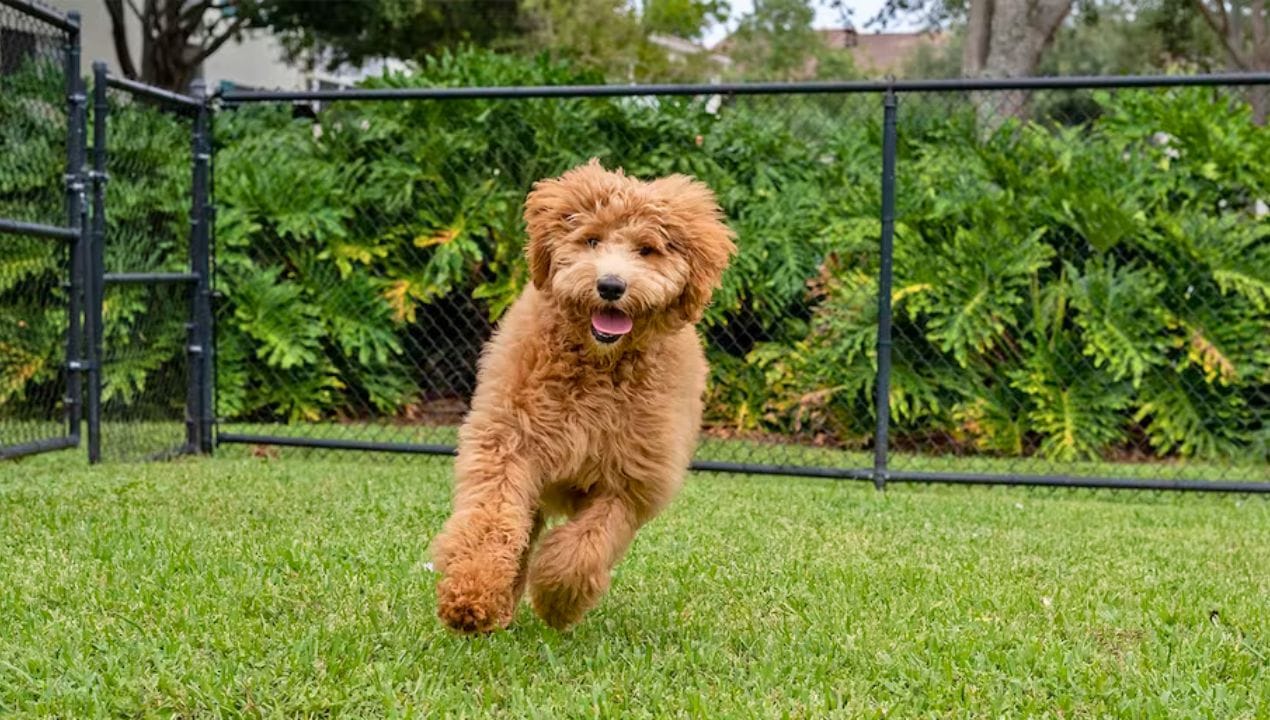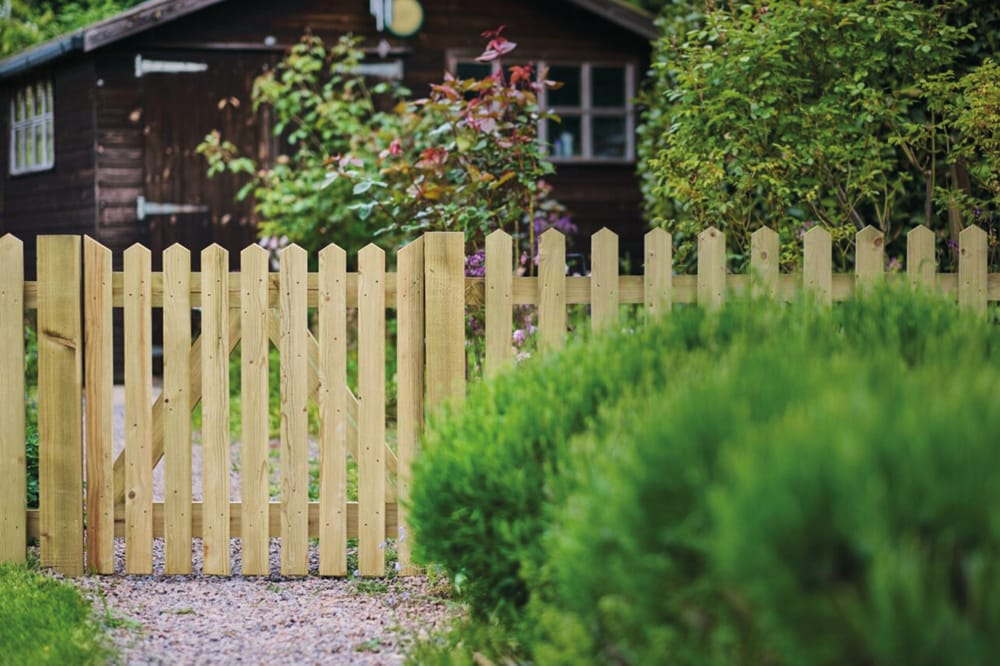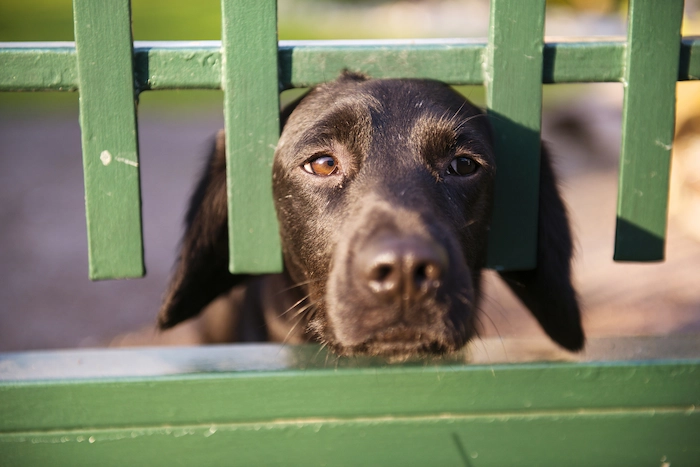Garden Fence for Dogs: Keeping your Furry Friend Safe and Secure
Garden fences are a great way to keep your furry friend safe and secure while enjoying the outdoors. Dogs love to explore, run around, and play in the yard, but it's important to keep them contained to prevent them from getting lost or injured. A garden fence for dogs is an excellent solution that provides a safe and secure environment for your pet to enjoy.

A garden fence for dogs can be made from a variety of materials, including wood, vinyl, aluminum, and chain link. The type of fence you choose will depend on your budget, the size of your yard, and your personal preferences. Some fences are designed to be more decorative, while others are built for function and durability. It's important to choose a fence that is sturdy and can withstand the elements, as well as your dog's playful nature.
A garden fence for dogs can also be customized to fit your specific needs. For example, you may want to add a gate to allow easy access to the yard, or you may want to install a taller fence to prevent your dog from jumping over it. Additionally, some fences can be designed to blend in with your landscaping or to match the style of your home. With so many options available, it's easy to find a garden fence for dogs that meets your needs and provides a safe and secure environment for your furry friend.
Understanding Dog Fences
Dog fences are essential for pet owners who want to keep their furry friends safe and secure in their yard. With so many options available, it can be challenging to choose the right one. This section will cover the different types of dog fences, selecting the right height and material, and the importance of durability.

Types of Dog Fences
There are various types of dog fences available, including vinyl, metal, wire mesh, chain link, privacy fences, electric fences, and invisible fences. Vinyl and metal fences are popular choices for their durability and low maintenance. Wire mesh and chain link fences are affordable and provide excellent visibility. Privacy fences offer complete privacy but can be expensive. Electric and invisible fences are ideal for those who want to keep their yard visually appealing.
Selecting the Right Height and Material
When selecting a dog fence, the height and material are crucial factors to consider. The fence should be high enough to prevent the dog from jumping over and escape. The right material should be durable enough to withstand the dog's weight and weather conditions. Vinyl and metal fences are sturdy and can withstand harsh weather conditions. Wire mesh and chain link fences are lightweight and may not be suitable for large and heavy dogs.
The Importance of Durability
Durability is essential when choosing a dog fence. The fence should be able to withstand the dog's weight and any attempts to escape. Vinyl and metal fences are durable and require minimal maintenance. Wire mesh and chain link fences are affordable but may not be as durable as vinyl or metal fences. It is essential to choose a fence that will last for a long time and provide reliable protection for your furry friend.
In conclusion, choosing the right dog fence requires careful consideration of the type, height, and material. It is essential to choose a fence that is durable, reliable, and provides adequate protection for your furry friend. With the right dog fence, you can ensure that your pet stays safe and secure in your yard.
Designing a Dog-Friendly Garden Fence
When it comes to designing a garden fence for dogs, there are a few things to keep in mind. Not only should the fence provide security and containment, but it should also be safe and comfortable for your furry friend. Here are some tips for designing a dog-friendly garden fence.
Fence Styles and Aesthetics
There are many different fence styles to choose from, but not all of them are suitable for dogs. Picket fences, for example, may not provide enough privacy or security for larger dogs. Privacy fences, on the other hand, can be a great option for dogs who like to bark at passersby. Lattice and trellis fences can also be a good choice, as they allow for airflow and visibility while still providing some level of containment.
In terms of aesthetics, consider incorporating flowers and other plants around the fence to create a more natural and inviting environment for your dog. Citrus trees and citronella plants can also help repel insects and other pests.
Integrating Play and Exercise Areas
A dog-friendly garden fence should also incorporate play and exercise areas for your furry friend. This can include a designated area for running and playing, as well as obstacles and toys to keep them entertained. A dog door or gate can also be installed in the fence to allow your dog to come and go as they please.
Incorporating Dog Repellent Plants
To keep your dog from digging under or jumping over the fence, consider incorporating dog repellent plants such as rosemary and lavender around the perimeter. These plants not only repel dogs, but they also add a pleasant scent to the garden.

Overall, designing a dog-friendly garden fence requires careful consideration of both function and aesthetics. By choosing the right fence style, integrating play and exercise areas, and incorporating dog repellent plants, you can create a safe and comfortable environment for your furry friend to enjoy.
Installation and Maintenance
DIY vs. Professional Installation
When it comes to installing a garden fence for dogs, homeowners have the option of doing it themselves or hiring a professional contractor. DIY installation can save money, but it requires time, effort, and some level of expertise. On the other hand, professional installation can be more expensive, but it ensures that the fence is installed correctly and can save time and hassle.
For those who opt for DIY installation, it is important to follow the manufacturer's instructions carefully and have all the necessary tools and supplies. Fence posts are a crucial component of the installation process, and they should be installed securely and at the correct depth to ensure stability.
Home Depot offers a wide range of fence materials and supplies, including fence posts, which can be purchased online or in-store. For those who prefer professional installation, Home Depot also offers installation services through their contractor network.
Maintaining Your Fence Over Time
Once the fence is installed, proper maintenance is essential to ensure its longevity and effectiveness. Regular inspections should be conducted to check for any damage or wear and tear, such as loose boards or rusted hardware. Any necessary repairs should be made promptly to prevent further damage.

To maintain the fence's appearance, it is recommended to clean it regularly with a mild detergent and water. This can help prevent the buildup of dirt, grime, and other debris that can cause discoloration or damage to the fence.
Overall, whether installed DIY or by a professional contractor, a garden fence for dogs can provide a safe and secure environment for pets to play and explore. With proper installation and maintenance, the fence can last for many years and provide peace of mind for pet owners.
Safety and Security Considerations
Preventing Escapes and Intrusions
When it comes to garden fencing for dogs, safety and security are of utmost importance. Pet parents must ensure that their furry friends are safely contained within the boundaries of their property. A fence that is too low or has wide gaps can lead to escapes or intrusions by other animals.
The height of the fence is a crucial factor in preventing escapes. A fence that is at least 6 feet tall is recommended for most breeds of dogs. Small dogs, however, may require a shorter fence. The spacing between the fence posts should be narrow enough to prevent dogs from squeezing through or getting their heads stuck.
Privacy is also an important consideration for preventing escapes and intrusions. A solid fence that blocks the view of squirrels and other animals can reduce the likelihood of dogs trying to jump over the fence or dig underneath it. Chicken wire or mesh fence can be added to the bottom of the fence to prevent diggers from tunneling out.
Sharp edges on the fence can be dangerous for dogs, so pet parents should avoid using wire fencing with sharp edges. Tenax Pet Fence and Dig Defence are two dog-proof garden fencing options that are safe for pets.
Ensuring Pet Safety Around Fences
Pet parents should also consider the safety of their dogs around the fence. Invisible fencing may seem like an attractive option, but it can be dangerous for dogs and may not be effective in keeping them contained. Instead, a fenced-in yard with a dog-proof fence is the safest option.
Poultry netting can be used to create a dog-friendly space within the yard for dogs to play without the risk of escaping. Zip ties can be used to secure the netting to the fence posts. Pet parents should also ensure that there are no sharp edges or gaps in the fence that could injure their dogs.
In conclusion, safety and security are essential considerations when choosing a garden fence for dogs. Pet parents should ensure that the fence is the appropriate height and spacing to prevent escapes and intrusions, while also being safe for their furry friends to play around. By taking these precautions, pet parents can create a safe and secure environment for their dogs.
Additional Features for Dog Owners
Integrating Entertainment and Comfort
Dog owners who want to enhance their pet's outdoor experience can consider adding entertainment and comfort features to their garden fence. One option is to install slats between the fence posts to create a slat fence. This type of fence provides privacy and security while still allowing dogs to see and hear what's going on outside. Slat fences are available in a range of materials, including wood and vinyl, and are pet safe and durable.
Another way to make the garden fence more comfortable for dogs is to provide them with a shaded area. This can be achieved by planting trees or installing a canopy over the fence. Owners can also create a designated area for their pet to relax by placing a comfortable bed or mat on the ground.

To keep dogs entertained, owners can install puzzle toys on the fence or provide them with chew toys. Additionally, owners can create a dog park within their yard by designating a specific area for playtime and installing agility equipment.
Temporary Solutions for Renters
For renters who want to keep their dogs safe and secure, temporary fencing solutions are available. One option is to install a chain-link fence, which is affordable, pet safe, and durable. Chain-link fences can be easily removed and reinstalled, making them an ideal choice for renters who move frequently.
Another option is to use a portable dog fence, which can be set up and taken down quickly. These fences are available in a range of sizes and materials, including mesh and vinyl. Portable dog fences are ideal for renters who want a temporary solution that can be easily moved from one location to another.
Overall, adding additional features to garden fences can provide dog owners with peace of mind, knowing that their pet is safe and comfortable. By considering the various fencing options and entertainment features available, owners can create a secure and enjoyable outdoor space for their furry friend.
Frequently Asked Questions
How can I effectively secure my garden to ensure it's safe for my dog?
To effectively secure your garden for your dog, you can start by determining the height of the fence needed to prevent your dog from jumping over it. It is also important to consider the type of fence material, gate, and lock that will best suit your needs. You can also consider adding a dig guard to prevent your dog from digging under the fence.
What materials are most durable for constructing a dog-proof garden fence?
Materials such as vinyl, wood, chain link, and metal are all durable options for constructing a dog-proof garden fence. It is important to choose a material that is strong enough to withstand your dog's weight and force, and also resistant to weather and other outdoor elements.
What are cost-effective solutions for keeping dogs out of a garden?
One cost-effective solution is to use chicken wire or mesh netting to create a barrier around your garden. Another option is to use plants or shrubs to create a natural barrier. You can also consider using a low-cost fencing material such as bamboo or PVC.
How can I build a dog fence for my garden that balances aesthetics and functionality?
To balance aesthetics and functionality, you can choose a fence material that complements the look of your garden and home. You can also add decorative elements such as planters or trellises to enhance the fence's appearance. It is important to ensure that the fence is still functional and secure for your dog.
Which fencing options are recommended for larger dog breeds in outdoor spaces?
For larger dog breeds, it is recommended to use a fence that is at least six feet tall and made of a durable material such as chain link or metal. It is also important to ensure that the fence is securely anchored into the ground to prevent your dog from knocking it over.
Are there non-fencing alternatives to prevent dogs from entering my garden?
Yes, there are non-fencing alternatives such as using motion-activated sprinklers or ultrasonic devices to deter dogs from entering your garden. You can also consider using natural deterrents such as citrus or vinegar sprays. However, it is important to note that these alternatives may not be as effective as a physical fence.